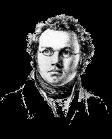composed in 1832 - Dedicati al Signore Kalliwoda
Allegro quasi maestoso,
A major
Presto a capriccio, E minor
Allegro marcato, A minor
Allegro semplice, C major
Allegro moderato, D minor
Allegro, B minor
| “The Intermezzi
will be something—every note is being carefully doled out.” “The silly
Intermezzo (No. 3) stays with me day and night.” “I feel a stirring inside
me that perhaps is virtue. But my whole heart was poured into you, my dear
Fifth Intermezzo, born with such ineffable love. Yesterday everything coalesced.”
Diary entry, 1832 |

Franz Schubert |
Intermezzi was what he called his
newest cycle, composed shortly after Papillons. The Intermezzi appeared
during interludes in his work on a Symphony in G minor, which remained
unfinished. A diary notice read: “Every one of the Intermezzi sprang directly
from life; only the last details are wanting. It has been a beautiful week:
pure, gentle, calm, and busy.” The work contains a number of musical
citations. They came from Lieder that Schumann had performed with the admired,
married Agnes Carus (Beethoven’s “An die ferne Geliebte” and Schubert’s
“Gretchens Spinnrad”), from Schumann’s own works (“Bin nur ein armer Hirtenknab”
of 1828, and the trio from the second movement of the Piano Quartet of
the same year), and notably the citation from the Abegg Variations, op.
1, in the last Intermezzo. The connection with the Abegg Variations continues
with the musical representation of Agnes Carus’ first name (the interval
employing the beginning “A” and ending “E-flat,” or “Es” in German).
© Franz Vorraber